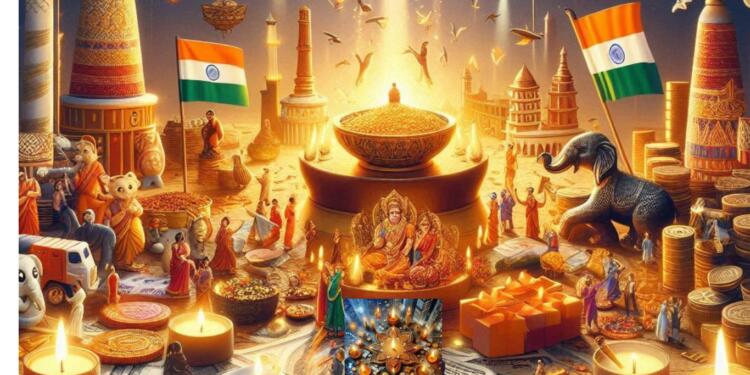One of the most cherished times of the year is from Dussehra to Diwali. The start of this festive season brings happiness to every corner of India. However, there is also a substantive section that lacks a basic understanding of Hindu traditions, which is why they feel very uneasy during this period. Driven by ignorance and hatred, they launch smear campaigns against Hindu culture and traditions, especially during the festive season.
This smear campaign is mainly done to paint Indian festivals as anti-science, which according to them are based on myths and blind faith and have relatively no use to society. However, it becomes important to debunk these malicious attempts against Hindu traditions, especially in the aspect that Hindu festivals spur growth in the Indian economy.
While there are many ways to silence them, like countering them with their version of freedom or telling them how McCauley and Marx’s ideas have deceived them and made them mentally colonised, however, what we prefer is silencing them on the economic aspect of these festivals.
As in Marxist tradition, society is a superstructure formed on the economic base.
The modern-day Capitalist economy works on perception and trends. Any development from festivals to wars, formation to fall of governments, or anything for that matter, the market always responds.
The government, which has reduced to merely a regulator, can only make an effect through policy introduction through which a demand would be generated.
But look at the long-established Indian tradition that synchronised every festival, small or big, in such a way that it generates heavy demands irrespective of inflation. In fact, their holistically inclusive approach provides happiness to everyone on the one hand and customers on the other hand. These festivals push the market and have time and again proved crucial in taking the nation’s economy upwards in times of hardship.
This is most evident right this time as reports suggest retailers are expecting a Diwali boost. Reports suggest that this year’s retail trade is likely to surpass pre-COVID levels.
Talking about 2023, last year, the annual festival saw a record retail trade of Rs 3.75 crore. The Chhath Puja, Bhaidooj, and other utsavs were additionals.
Dussehra, which manifests Ram Leela and fairs at the lowest administrative level boosts trade for an uncountable number of businesses from street vendors to prominent names.
The sale of handicrafts, artifacts, eateries, and whatnot skyrockets. The trade registers a massive surge in the Diwali festive season, the same will be the case this time, and even better. In several parts of India, Durga Puja also fosters economic growth in the region.
The subsequent festival of Karwa Chauth also witnessed booming markets with customers flooding the streets. According to an estimate, this year, the retail trade on Karwa Chauth likely crossed Rs 22,000 crores, which is far more than what it was last year when retail trade was Rs 15,000 crores on the day.
After this comes consecutive days of festivities. Dhanteras, a day revered for purchasing as a sign of prosperity, leads to huge retail trade. The most important aspect of this festival is its inclusivity. From diamond to a spoon, every purchase is considered equally auspicious, a fact that could disturb the critics of Indian cultural festivals.
Last year Dhantera trade touched Rs 33 crores and as said earlier, the festivals impacted the free market, investors also started infusing money in Gold (Export Trade Funds) ETF.
Talking about this year, ICRA analysts stated that Gold ETF was at Rs 657.46 crore in January. This rose by 88 percent to Rs 1,232.99 crore till September.
So the festivals are not only generating demand, but they are also driving investors.
Looking at the holistic picture, the Retail trade between Dussehra to Diwali touched Rs 5 lakh crore in 2023. This year it is likely to hit a new high.
This was the economics of the festivals now let’s understand about festival’s role as India’s soft power and policy determinent.
Diwali and other Indian festivals are celebrated all across the world. No radicalisation or harassment of one’s freedom in the name of traditional rigidity increases these festival’s acceptance. Some of the most powerful places like the White House celebrate Diwali with full fervour. Also, the Indian Diaspora uses these festivals to spread the message of India to the world.
The festivals also provide India, as a nation, an opportunity to dictate its free will in trade. A couple of years earlier, 70 percent of the products that Indian consumers bought were from China. Last year, Indians proactively went after the Made in India products. Resultantly, while the retail trade rose to 3.75 lakh crore, Chinese products incurred losses to the tune of Rs 1 lakh crore.
Simply put, the festivals boost the nation’s economy, act as safe power, and provide a basis for taking bold steps in favour of the economy. So, those painting Indian festivals in a bad light first speak on the shape of the Indian GDP without these hefty market-fueling festivals.































